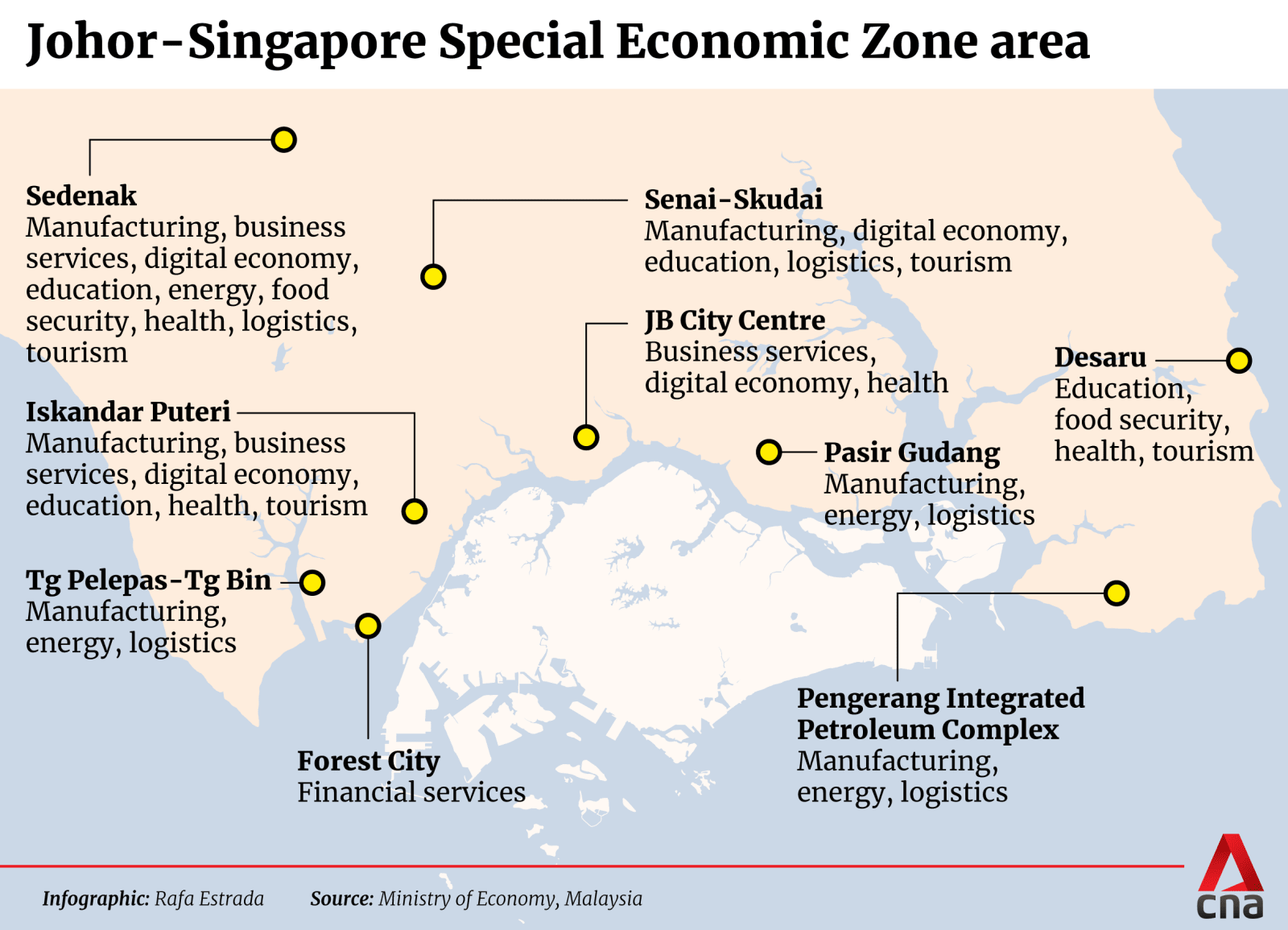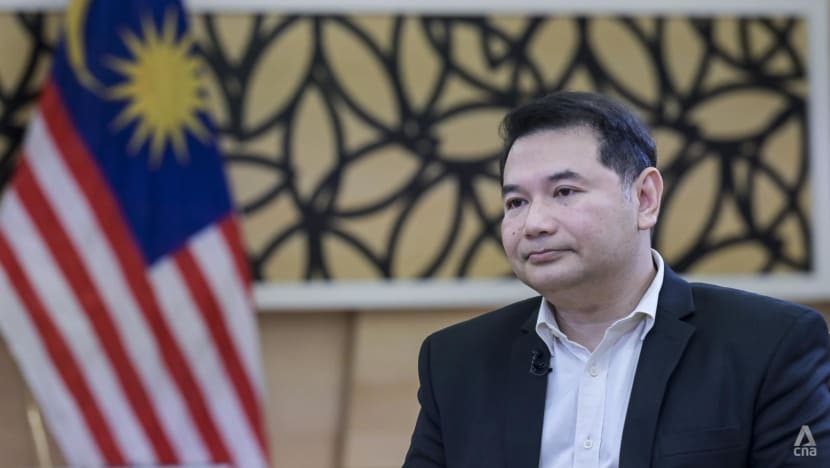Advertisement
analysis Asia
Malaysia’s Economy Minister Rafizi Ramli has told reporters that infrastructure for the special economic zone in Johor will be developed on a “project-by-project” basis, while Malaysia would fund infrastructure and Singapore is to finance investment facilitation. Analysts say such a split financing model is “fair”.

The exchange of Memorandum of Understanding (MOU) for the Johor-Singapore Special Economic Zone between Singapore Deputy Prime Minister Gan Kim Yong and Malaysia’s Economy Minister Rafizi Ramli at the Prime Minister’s Office in Putrajaya. (Photo: CNA/Fadza Ishak)
New: You can now listen to articles. 
This audio is generated by an AI tool.

08 Jan 2025 06:00AM
JOHOR BAHRU: Malaysia’s blueprint to develop infrastructure for the Johor-Singapore Special Economic Zone (JS-SEZ) on a project-by-project basis is a pragmatic and cautious move, keeping in mind the country’s debt and its other pressing priorities, analysts told CNA.
But some business leaders have expressed concerns that this phased approach could lead to delays in infrastructure completion, potentially disrupting investors’ operations and their expansion plans. They also raised concerns that the model could add red tape and lengthen bureaucratic processes.
Their comments come on the back of the exchange of agreement on the JS-SEZ that was witnessed by Singapore Prime Minister Lawrence Wong and Malaysia Prime Minister Anwar Ibrahim in Putrajaya on Tuesday (Jan 7).
Malaysia’s Economy Minister Rafizi Ramli had told reporters in a briefing last Friday that the JS-SEZ agreement lays out funding obligations for both countries, with Malaysia providing funding for infrastructure and Singapore providing funding to facilitate investments.
The JS-SEZ will also operate on a “project-by-project” basis, Rafizi said, meaning infrastructure will be built as projects and investments are agreed as opposed to the conventional arrangement of building infrastructure before attracting investments.
“It’s a lot quicker because then investors have that flexibility to identify which area they think is best suited for their operations, rather than the traditional mode of you can only go there because that’s the only place that the government has invested (in) for infrastructure and so on,” he said.
Rafizi added that Malaysia was keen on this new model, as the older blueprint on which Iskandar Malaysia was developed led to uneven progress and projects that were not well received.
“That is the story of Iskandar. The government for the last 20 plus years spent billions preparing everything. And then some areas actually get some progress, some areas don’t get progress,” said Rafizi.
“So learning from that experience, we prefer to do it in tandem and with basically the input from the investor right from the very beginning.”
The Iskandar Malaysia project was conceptualised in 2006 under the government led by then-prime minister Abdullah Ahmad Badawi. However, the project fizzled out, attributed by what some observers say is a lack of political will and interest from foreign investors.
BUILD-AS-YOU-GO MODEL DOES NOT REASSURE INVESTORS: BUSINESS HEADS
Singapore Manufacturing Federation (SMF) president Lennon Tan told CNA that the project-by-project model offers a more flexible and demand-driven approach, and that this was a “positive shift from earlier large-scale speculative developments like Iskandar Malaysia”.
However, he added that some Singapore manufacturing firms have concerns over the execution of this model and whether infrastructure can be completed in a timely manner.
“While the phased approach reduces overbuilding risks, delays in infrastructure completion can disrupt manufacturers’ operations and expansion plans. Investors need assurance that timelines for each phase will be met without undue delays,” said Tan.
He added that there was also concern that this model could lengthen bureaucratic processes and red tape to obtain necessary permits – as opposed to firms moving into completed industrial parks and buildings that have already been built with all the amenities.
“While the project-by-project model is promising, SMF emphasises that predictability, accountability, and proactive investor engagement will be key to its success.
“Manufacturers are willing to adapt to this dynamic model but require robust governance to mitigate risks,” said Tan, who also called on Malaysian authorities to establish and communicate clear timelines for infrastructure development as well as to ensure regular progress updates.

These sentiments are shared by Teh Kee Sin, advisor of the Small and Medium Enterprise Association of South Johor.
The business leader noted that the market-response approach is “more prudent” as it manages risks conservatively, especially given the Malaysian government’s finite resources.
“But on the other hand, would foreign investors come if they see that there is no assurance on basic infrastructures like Wi-Fi (or) electricity. All these are basic (amenities) and every investor would only go in if there is a guarantee these are already in … It’s a chicken and egg situation – nobody is going to invest if there is no ready infrastructure,” said Teh.
He added that there have been instances in Johor where companies would relocate to an industrial facility only to find that the electricity available is insufficient for their operations.
“Companies have to expend resources to lay their own cables. Foreign companies would not be willing to do this and they will look at the situation differently (on whether to invest),” he said.
Meanwhile, economist Anthony Dass – who is the executive director for the Malaysian Institute of Economic Research – was more sanguine on the new model, outlining how it tailors infrastructure to actual needs of investors.
“The project minimises wasteful spending on underutilised assets, improving efficiency and reducing financial risk … This model allows flexibility for adjustments based on economic trends and market conditions, avoiding the pitfalls of oversupply seen in earlier projects like Iskandar Malaysia,” said Dass.
However he, too, acknowledged that the model could lead to delays especially if investors adopt a wait-and-see approach.
“The SEZ’s growth may progress unevenly, which could hinder its overall impact,” added Dass.
SPLIT FUNDING ‘FAIR’, LEVERAGES ON COMPARATIVE ADVANTAGES: ANALYSTS
During the briefing last Friday, Rafizi also emphasised that the funding for the SEZ will be split, with Malaysia funding infrastructure for the economic zone while Singapore funds the facilitation of investments and expansion of companies.

Rafizi added that the “difficulty for JS-SEZ” compared to most of the other economic zones elsewhere is that it involves two countries with two jurisdictions – and that it is not easy to have the taxpayer of one country to be seen as subsidising the project in another country.
The economist Dass lauded the move as it allows for the leveraging of comparative advantages – with Malaysia banking on its expertise on large-scale infrastructure projects aligned with its focus on job creation, capacity building, and long-term economic development while Singapore’s strength is in attracting multinational companies and expanding upon high-value investments.
“There is also risk sharing. Dividing responsibilities reduces financial pressure on either country, allowing each to focus on areas where they can deliver maximum impact,” said Dass.
Lee Heng Guie, an economist and executive director of the Socio-Economic Research Centre in Malaysia, agreed that the model is positive and it divides the funding “fairly”.
He said that it was fair that Malaysia finance infrastructure such as power and other utilities, roads and buildings as they are in Johor land, while Singapore may help with the financing and incentives for companies who wish to invest in the SEZ.
“It is deemed appropriate and sustainable since the SEZ is located in Johor,” said Lee.
However, he posited that both governments should consider accepting private funding, citing how some economic zones in China are financed by state-owned banks and managed by private firms.
Lee suggested that firms could finance infrastructure and help companies with start-up capital, and this could be a faster way to kickstart the JS-SEZ.
“The participation of self-funding (by) the private sector can reduce the financial burden on the government to manage the SEZ,” said Lee.
However, Dass warned that the current split financing model could lead to potential imbalance in return of investments for both Singapore and Malaysia.
“Singapore’s funding in investments may lead to faster returns, while Malaysia’s infrastructure spending may only yield long-term benefits, creating an uneven distribution of immediate economic gains,” said Dass.
He suggested that the model may only be sustainable if both countries conduct reviews to ensure that the benefits reaped are “balanced”.
“Periodic reviews of responsibilities and contributions may be needed to address potential disparities and refine the framework,” he added.
Commenting on the overall JS-SEZ agreement, Malaysia’s former deputy trade and industry minister Ong Kian Ming told CNA that the identification of the 11 economic sectors will provide impetus for government-linked companies and private sectors on both sides of the border to start aligning their own corporate interests with the interests of both governments.
The JS-SEZ, which was first mooted in July 2023, will span 3,571 sq km and comprise nine “flagship areas” catering to different economic sectors.
“The fact that the agreement states that both countries will continue to explore new areas of cooperation and initiatives leaves the door open for more interesting ideas and projects to be included as part of the JS-SEZ over time,” said Ong, who is also Pro Vice Chancellor of External Engagement at Malaysia’s Taylor’s University.
“Although I was hoping for more substantive measures to be announced, including special incentives for knowledge workers and tech companies in the JS-SEZ, I think that this is a good start to the long-awaited announcement.”
Additional reporting by Rashvinjeet S Bedi.
